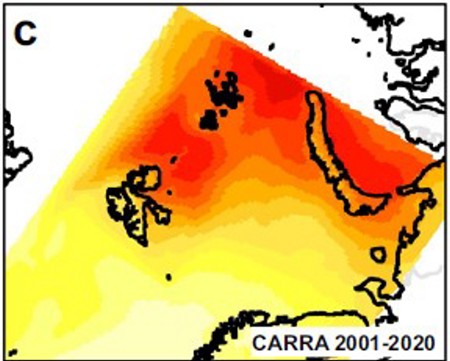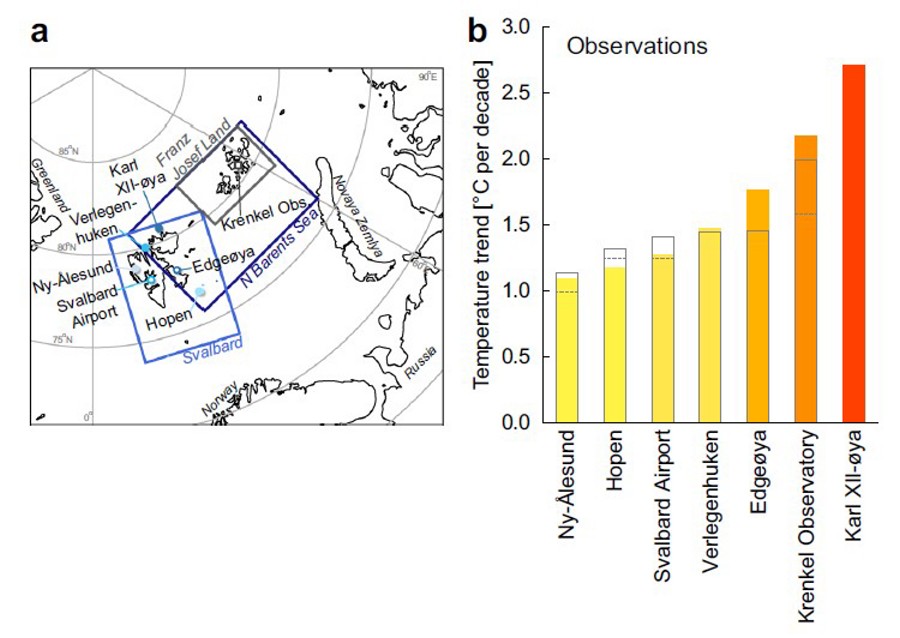weblog 2022 |
|
[home] [weblog] [science] [people] [station] [ny-ålesund] [sightings] [sitemap] [nederlands] |
|
east Svalbard warms fastest | 15 June 2022 | ||||||||||||||||||||||||||||||||||||||||||||||||||||||||||||
A new analysis of temperature and sea ice data in the Barents Sea region shows that the north east warms fastest and more than was known before. The area has only a few sites with meteorological observations, but new developed re-analysis gives a clear geographical pattern. Isaksen et al. (2022) Exceptional warming over the Barents area. Scientific Reports 12: 9371. These results are highly relevant for the SEES.nl expedition, which will take place this summer from 13 to 22 July. While most environmental data are collected in Ny-Ålesund, the island Edgeøya is warming faster. The comparison between these two sites is based on observational data from meteorological stations. During the expedition we will study changes on Edgeøya with an interdisciplinary team of 50 scientists and discuss the consequences of climate change. We did this before in 2015 and were successfull in science, outreach and building a community of scientists and science supporters. |  |
||||||||||||||||||||||||||||||||||||||||||||||||||||||||||||
 Temperature trends based on instrumental observations. (a)
The location of the main stations and main regions in the study. (b) Linear trends for annual surface air temperature series for the period 2001–2020.
Temperature trends based on instrumental observations. (a)
The location of the main stations and main regions in the study. (b) Linear trends for annual surface air temperature series for the period 2001–2020. | |||||||||||||||||||||||||||||||||||||||||||||||||||||||||||||
The table above shows the faster increase in surface aie temperature in Edgeøya than in Ny-Ålesund. The biggest effects happen in the months December, January and February and are strongly correlated with the ice cover in the region. Only in summer (jja), Ny-Ålesund has been warming faster. The ice cover plays an important role as it caps the ocean and blocks heat transfer from the water into the atmosphere. Without ice, heat is escaping into the atmosphere together with water vapour, which also warmns the atmosphere similar to climate forcing gasses. With elevated temperatures the atmosphere can hold more water vapour, resulting in more precipitation. In winter, without sunlight, increased cloud cover blocks the heat escaping to higher altitudes. In summer, with the sun returned, clouds reflect sunlight which reduces warming. Welcome in my course Climate Change given at the University of Groningen. | |||||||||||||||||||||||||||||||||||||||||||||||||||||||||||||
[home] [weblog] [science] [people] [station] [ny-ålesund] [sightings] [sitemap] [nederlands]

|
|||||||
| [previous] | [present] | [next] | [overview] | ||||
 |
 |
 |
 |
||||
| 20220615, 14:00 | 20220615, 22:10 | 20220616, 04:30 | all items shown with small pics | ||||
| village tour | east Svalbard warms fastest | night interview with mo |
This page has been given the following keywords: [global warming] [landscape] You can click on each keyword to get an overview about related pages. |